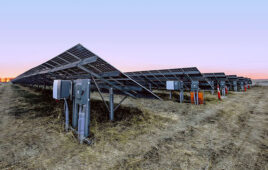The NFPA has published the 2017 edition of the National Electrical Code, and technically, as of Jan. 1, any state could adopt the code’s new rules. However, as with any code cycle, there will be a lag in adoption. California is just beginning to enforce NEC 2014 this year. Still, any solar contractor installing on “the rooftop of an occupied building” needs to be aware of the new code changes.
One of the most controversial additions to the 2017 code mandates conductors within 1 ft of the PV array boundary or point of entry into a building, or within 3 ft of an entry into a building, must be reduced to 80 V or less within 30 seconds of rapid shutdown initiation. Of the three options the 2017 code allows for compliance with rapid shutdown, the use of module level isolation is the most readily available using current equipment. Module-level isolation has been hotly debated in the industry since it was proposed during the 2017 NEC revision cycle. First responders see limiting the voltage anywhere within the array to 80 V or less as a step toward increased safety, and MLPE providers are obviously on board since their devices would be required. Other parties like SEIA, SunPower and SolarCity opposed the addition, concerned it would hamper the industry in terms of cost and reliability and not entirely convinced it makes arrays safer.

Meeting NEC 2017 rapid shutdown today
While NEC 2014 rapid shutdown requirements only limited voltage for the wiring outside of a certain perimeter around the array, NEC 2017 added detail by limiting the voltage at the module level. While there are various ways to achieve this, only one is possible with the technology and standards commercially available today—isolating or separating modules in a string through module-level electronics. Inverter manufacturers have taken the lead on providing solutions to meet the code.
Using power optimizers or microinverters alone, or as integrated smart or AC modules, will inherently meet the code requirements. A string inverter will have to be paired with some type of module-level technology. String inverter manufacturers are taking different approaches, offering DC optimizers for every module or partnering with MLPE or panel manufacturers with integrated technology that already meets the code—optimizers, microinverters and even chips.
For example, SMA America has partnered with Tigo Energy to offer a range of MLPE options, from those that simply shutdown the module to those that offer additional benefits such as monitoring and shade mitigation. The company’s director of marketing Brad Dore said the right choice for contractors depends on their business model.
“What’s the most cost effective way to meet the code, and what does your design dictate you need?” he asked. “With many incumbent microinverter and optimizer companies, you’re putting one of these MLPEs on each module no matter what. With SMA’s, if an integrator just wants shutdown capability, they can utilize a particular MLPE that’s just for that purpose. It doesn’t provide monitoring, shade mitigation or other benefits of an actual optimizer, but it’s less expensive. Likewise, there are module companies that have MLPEs embedded into the module that can provide similar benefits. It’s really up to the integrator to determine what’s best for his or her business model.”

The future of rapid shutdown
It’s important to be aware of the options available today to meet the code, just in case you’re lucky to have an inspector keen on immediately enforcing NEC 2017 (Massachusetts may be one of these early adopters). But Mike Mahon, technical training specialist at SMA America, noted the code actually delays enforcing rapid-shutdown requirements in 690.12(B)(2) until January 1, 2019. This is to allow time for the industry to develop a product safety standard for rapid-shutdown PV arrays, so that arrays may be listed and labeled as rapid-shutdown installations. The NFPA recognizes that some options don’t exist yet.
“While it was decided this addition should be in print before the next code cycle, there was an understanding that there’s a lack of maturity in the solutions available for compliance,” he said.
Mahon explained that one compliance method describes a UL-listed rapid shutdown system (RSS) PV array, which is a UL standard that doesn’t currently exist. “It would require a standard testing procedure to be developed to achieve that listing,” he said. “Then an array or install could be in compliance.”
The SunSpec Alliance is also working on a communication protocol that allows module manufacturers to produce a basic remote control switch for shutdown. “As time goes on, we’ll have more and more options for getting there,” Mahon said.
“There is a lot of work to be done before the full suite of solutions is available,” Dore agreed. “That’s not terribly unusual. We saw a similar play-out in the 2011 cycle requiring arc-fault circuit interrupter functionality. That code was written, and 2011 came without any commercially available way to meet the code requirements.” But implementation was delayed and solutions came to market.
Dore said another interesting aspect is how the code requirement impacts the cost of the system. “It’s in the best interest of the industry’s growth to provide additional safety but in a responsible way so the cost is minimal,” he said. “The residential market, so far, has been a little better able to absorb the additional cost of using MLPEs. Some of these ‘to be developed’ solutions may find applications in the commercial market, which has a little less price elasticity. The same code applies to the commercial market, even though that market is more sensitive to pricing. When you think about the construction and design of a rooftop, it’s something that will need to be taken into account. The solutions are still to come.”






In regards to the new rapid shutdown requirements I was wondering if such devices such as Gas Filled Contactors are a consideration as to a solution to this new requirement being beveloped?
I would like to thank everyone for their comments on this article. We’ve made some revisions to improve the article’s accuracy. Thanks so much for reading and helping us improve to provide the best content possible to our audience!
Great update on RSS. I would add though that the 2017 NEC does not mandate module level shutdown. But the mandates it does establish will probably require some type of MLPE with the use of current designs. Alternate designs that limit string voltages to 80V, glass on glass modules with non-metalic mounting, or the promised UL listed PV array are all acceptable alternatives to module level isolation. It will be interesting to see what types of designs and equipment end up providing the required safety at the lowest cost.
Thank you Marvin – you beat me to the reply. It would behoove anyone who reads this article to actually read the 2016 code covering Rapid Shutdown, as this article has a few errors in it. A 1 foot boundary around the array has been established, reduced from the 10 foot distance introduced in the 2014 code cycle, for instance.
I let a typo slip in – I meant the 2017 code should be read…
Module level electronics that are reliable and low cost must be by definition simple. In 2009, long before the idea of rapid shutdown was considered, Helios Focus developed a rapid shutdown technology that is as simple and reliable. Tested for a number of years in the Arizona desert it is a licensable technology ready for these new stringent NEC requirements. For more information check out: http://www.heliosfocus.com/wp-content/uploads/2016/09/Helios-Focus-Technical-review-v3.4.pdf